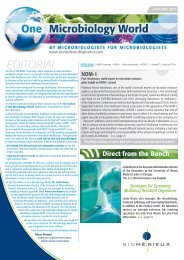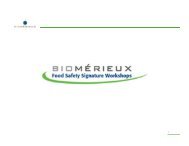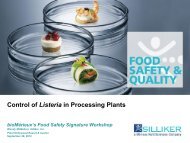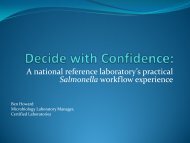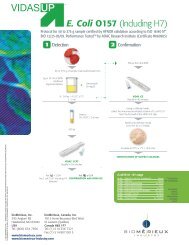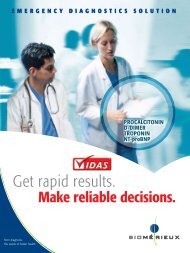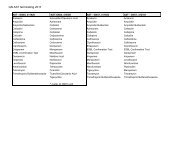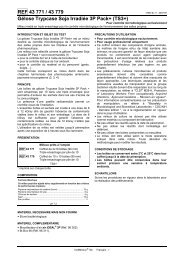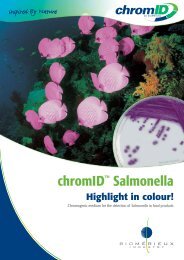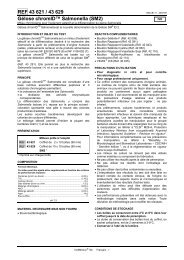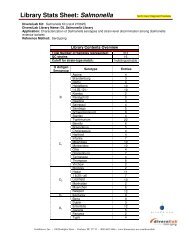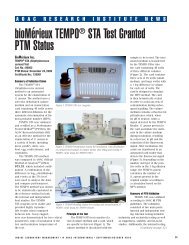REF 42 634 BOUILLON THIO - CLAIR Salles Propres ... - bioMerieux
REF 42 634 BOUILLON THIO - CLAIR Salles Propres ... - bioMerieux
REF 42 634 BOUILLON THIO - CLAIR Salles Propres ... - bioMerieux
You also want an ePaper? Increase the reach of your titles
YUMPU automatically turns print PDFs into web optimized ePapers that Google loves.
<strong>REF</strong> <strong>42</strong> <strong>634</strong> 13736 B - fr - 2007/10<br />
<strong>BOUILLON</strong> <strong>THIO</strong> - <strong>CLAIR</strong> <strong>Salles</strong> <strong>Propres</strong> (<strong>THIO</strong>C-SP)<br />
Test de stérilité. Filtration sur membrane.<br />
INTRODUCTION ET OBJET DU TEST<br />
Le <strong>BOUILLON</strong> <strong>THIO</strong> – <strong>CLAIR</strong> <strong>Salles</strong> <strong>Propres</strong> est un<br />
bouillon Thioglycolate avec résazurine , destiné à la<br />
recherche des bactéries anaérobies. Il permet également<br />
la croissance des bactéries aérobies.<br />
Ce milieu est conforme aux pharmacopées européenne,<br />
américaine et japonaise (1, 2, 3) pour les tests de stérilité<br />
par filtration sur membranes.<br />
PRINCIPE<br />
Ce bouillon contient un mélange de peptones permettant<br />
la croissance de la plupart des micro-organismes.<br />
La présence d’agents réducteurs (L-cystine et<br />
thioglycolate de sodium) et d’extrait de levure favorise la<br />
croissance des germes anaérobies.<br />
L'indicateur d'oxydo-réduction (résazurine) permet de<br />
visualiser la présence d'oxygène (coloration rose à<br />
mauve).<br />
Les flacons de <strong>BOUILLON</strong> <strong>THIO</strong> – <strong>CLAIR</strong> <strong>Salles</strong> <strong>Propres</strong><br />
sont conditionnés en coffret plastique ensaché par une<br />
double enveloppe et traité à l’oxyde d’éthylène.<br />
Ce conditionnement facilite l’accès dans la zone protégée,<br />
limite le risque de contamination liée au carton et évite la<br />
décontamination préalable des flacons.<br />
La présence d’un témoin de traitement permet un contrôle<br />
visuel du traitement à l’oxyde d’éthylène.<br />
Le traitement à l’oxyde d’éthylène garantit l’abattement de<br />
10 6 spores de Bacillus subtilis, au niveau :<br />
de l'extérieur des flacons, de l'étui plastique et des 2<br />
sachets.<br />
Ce traitement n’altère pas les spécifications du milieu.<br />
PRESENTATION<br />
Milieu prêt à l’emploi<br />
<strong>REF</strong> <strong>42</strong> <strong>634</strong> Coffret contenant un étui plastique<br />
double ensaché de 6 flacons de 100 ml<br />
COMPOSITION<br />
Formule théorique :<br />
Ce milieu peut être ajusté et/ou supplémenté en fonction des critères<br />
de performances imposés:<br />
Hydrolysat pancréatique de caséine (bovin) ...............................15 g<br />
L-cystine ...................................................................................0,5 g<br />
Glucose monohydraté/anhydre.......................................5,5 g / 5,0 g<br />
Extrait de levure .......................................................................... 5 g<br />
Chlorure de sodium ..................................................................2,5 g<br />
Thioglycolate de sodium ...........................................................0,5 g<br />
ou acide thioglycolique ............................................................0,3 ml<br />
Résazurine ...........................................................................0,001 g<br />
Agar ........................................................................................0,75 g<br />
Eau purifiée ...................................................................................1 l<br />
pH 7,1<br />
REACTIFS ET MATERIEL NECESSAIRES MAIS NON<br />
FOURNIS<br />
Réactifs :<br />
• Fluid A Solution de rinçage (Réf. <strong>42</strong> 044 ou <strong>42</strong> 616).<br />
• Fluid D Solution de rinçage (Réf. <strong>42</strong> 624).<br />
• <strong>BOUILLON</strong> TRYPCASE SOJA <strong>Salles</strong> <strong>Propres</strong><br />
(Réf. <strong>42</strong> 633).<br />
bioMérieux ® SA Français - 1<br />
Pour contrôle microbiologique exclusivement<br />
Matériel :<br />
• Etuve bactériologique.<br />
REACTIFS COMPLEMENTAIRES<br />
• Aiguilles stériles pour aération.<br />
• Unité de filtration.<br />
PRECAUTIONS D’UTILISATION<br />
• Pour contrôle microbiologique exclusivement.<br />
• Pour usage professionnel uniquement.<br />
• Ce coffret contient des composants d'origine animale.<br />
La maîtrise de l'origine et/ou de l'état sanitaire des<br />
animaux ne pouvant garantir de façon absolue que ces<br />
produits ne contiennent aucun agent pathogène<br />
transmissible, il est recommandé de les manipuler avec<br />
les précautions d'usage relatives aux produits<br />
potentiellement infectieux (ne pas ingérer; ne pas<br />
inhaler).<br />
• Les prélèvements, cultures microbiennes et produits<br />
ensemencés doivent être considérés comme<br />
potentiellement infectieux et doivent être manipulés de<br />
façon appropriée. Les techniques aseptiques et les<br />
précautions usuelles de manipulation pour le groupe<br />
bactérien étudié doivent être respectées tout au long de<br />
la manipulation; se référer à " CLSI ® M29-A, Protection<br />
of Laboratory Workers From occupationally Acquired<br />
Infections; Approved Guideline – Révision en vigueur".<br />
Pour informations complémentaires sur les précautions<br />
de manipulation, se référer à "Biosafety in<br />
Microbiological and Biomedical Laboratories – CDC/NIH<br />
- Dernière édition ", ou à la réglementation en vigueur<br />
dans le pays d'utilisation.<br />
• Les milieux de culture ne doivent pas être utilisés<br />
comme matériau ou composant de fabrication<br />
• Ne pas utiliser les réactifs après la date de péremption.<br />
• Ne pas utiliser des flacons présentant une suspicion de<br />
contamination.<br />
• Avant utilisation, procéder à une décontamination de<br />
l’extérieur des flacons et du septum gris , si :<br />
- le coffret plastique ne présente pas une découpe ronde<br />
sur le couvercle.<br />
- les sachets présentent une altération de leur intégrité.<br />
- un opercule plastique est présent sur le septum gris.<br />
• Ne pas utiliser des flacons présentant un anneau rosemauve<br />
en surface supérieur à 1 cm (observation<br />
effectuée sur le milieu au repos).<br />
• Ne pas utiliser les flacons dont le bouillon présente une<br />
couleur autre que jaune.<br />
• Selon les recommandations de la Pharmacopée<br />
Européenne, la manipulation doit avoir lieu dans un<br />
environnement de classe A dans B, ou dans un<br />
isolateur.<br />
• Le milieu doit être utilisé selon le mode opératoire<br />
indiqué dans cette notice. Toute déviation de<br />
méthodologie peut modifier les résultats.
<strong>BOUILLON</strong> <strong>THIO</strong> - <strong>CLAIR</strong> <strong>Salles</strong> <strong>Propres</strong> (<strong>THIO</strong>C-SP) 13736 B - fr - 2007/10<br />
CONDITIONS DE STOCKAGE<br />
• Les flacons se conservent entre 2°C et 25°C dans<br />
leur coffret jusqu’à la date de péremption.<br />
• Ne pas congeler.<br />
ECHANTILLONS<br />
Suivre les recommandations des pharmacopées pour la<br />
préparation des échantillons.<br />
MODE OPERATOIRE<br />
Test de stérilité par filtration sur membrane :<br />
Selon la méthode décrite dans les pharmacopées, il est<br />
nécessaire de respecter la technique suivante :<br />
1. Filtrer une petite quantité de Solution de rinçage<br />
(Fluid A ou Fluid D) sur chaque membrane.<br />
2. Diviser le produit à examiner en deux parties égales et<br />
les filtrer sur des membranes différentes. La quantité à<br />
filtrer dépend de la nature du produit et de la quantité<br />
par récipient.<br />
3. Rincer chaque membrane avec 100 ml de Solution de<br />
rinçage. Le nombre de rinçages dépend du produit<br />
testé.<br />
4. Introduire 100 ml de <strong>BOUILLON</strong> TRYPCASE SOJA<br />
<strong>Salles</strong> <strong>Propres</strong> sur l'une des membranes et 100 ml de<br />
<strong>BOUILLON</strong> <strong>THIO</strong> – <strong>CLAIR</strong> <strong>Salles</strong> <strong>Propres</strong> sur l'autre.<br />
5. Incuber pendant 14 jours au minimum :<br />
- <strong>BOUILLON</strong> TRYPCASE SOJA <strong>Salles</strong> <strong>Propres</strong> à<br />
20-25°C.<br />
- <strong>BOUILLON</strong> <strong>THIO</strong> - <strong>CLAIR</strong> <strong>Salles</strong> <strong>Propres</strong> à 30-35°C.<br />
Ensemencement direct :<br />
Suivre les méthodes décrites dans les pharmacopées.<br />
Il est possible d’utiliser la présentation en tubes prêt-àl’emploi<br />
(Réf. <strong>42</strong> 018) (voir la notice correspondante).<br />
LECTURE ET INTERPRETATION<br />
Se référer aux indications des pharmacopées.<br />
Après incubation, observer la croissance microbienne qui<br />
s’accompagne généralement d’un trouble du bouillon.<br />
CONTROLE DE QUALITE<br />
Le <strong>BOUILLON</strong> <strong>THIO</strong> - <strong>CLAIR</strong> <strong>Salles</strong> <strong>Propres</strong> est conçu et<br />
développé afin de répondre aux exigences de qualité les<br />
plus strictes.<br />
Les résultats des souches testées lors du contrôle de<br />
qualité lot par lot figurent sur le certificat de contrôle<br />
qualité est disponible sur demande.<br />
CLSI est une marque utilisée, déposée et/ou enregistrée appartenant à Clinical and Laboratory Standards Institute Inc.<br />
ATCC est une marque utilisée, déposée et/ou enregistrée appartenant à American Type Culture Collection.<br />
bioMérieux ® SA<br />
au capital de 12 029 370 €<br />
673 620 399 RCS LYON<br />
LIMITES DU TEST<br />
• Le développement est fonction des exigences propres à<br />
chaque micro-organisme. Il est donc possible que<br />
certaines souches ayant des exigences spécifiques<br />
(substrat, température, atmosphère d'incubation…) ne<br />
se développent pas.<br />
• Etant donnée la diversité des échantillons testés, il est<br />
de la responsabilité de l’utilisateur de valider ce milieu<br />
dans son application.<br />
• Compte-tenu de la variabilité observée sur les virages<br />
des témoins de traitement à l’oxyde d’éthylène, ce<br />
résultat n’est pas utilisé comme critère libératoire du lot.<br />
La libération du lot est réalisée sur la conformité des<br />
résultats des indicateurs biologiques.<br />
• La croissance du Bacteroides vulgatus ATCC ® 8482<br />
nécessite une incubation de 4 à 7 jours à 30-35°C<br />
ELIMINATION DES DECHETS<br />
Eliminer les réactifs utilisés et non utilisés ainsi que les<br />
matériels à usage unique contaminés en suivant les<br />
procédures relatives aux produits infectieux ou<br />
potentiellement infectieux.<br />
Il incombe à chaque laboratoire de gérer les déchets et<br />
les effluents qu'il produit selon leur nature et leur<br />
dangerosité, et d'en assurer (ou faire assurer) le<br />
traitement et l'élimination selon les réglementations<br />
applicables.<br />
<strong>REF</strong>ERENCES BIBLIOGRAPHIQUES<br />
1. Pharmacopée Européenne 6.<br />
2. USP 30.<br />
3. Pharmacopée Japonaise 15.<br />
TABLE DES SYMBOLES<br />
Symbole Signification<br />
69280 Marcy-l'Etoile / France<br />
Tél. 33 (0)4 78 87 20 00<br />
Fax 33 (0)4 78 87 20 90<br />
http://www.biomerieux.com<br />
Référence du catalogue<br />
Fabricant<br />
Limites de température<br />
Utiliser jusque<br />
Code du lot<br />
Consulter les instructions<br />
d'utilisation<br />
Contenu suffisant pour "n" tests<br />
Imprimé en France<br />
bioMérieux et le logo bleu sont des marques utilisées, déposées et/ou enregistrées appartenant à bioMérieux SA ou à<br />
l'une de ses filiales.
<strong>REF</strong> <strong>42</strong> <strong>634</strong> 13736 B - en - 2007/10<br />
CLEAR - <strong>THIO</strong> BROTH - Clean Rooms (<strong>THIO</strong>C-SP)<br />
Sterility testing by membrane filtration.<br />
SUMMARY AND EXPLANATION<br />
CLEAR – <strong>THIO</strong> BROTH – Clean Rooms, Thioglycollate<br />
broth with resazurin, is intended for the detection of<br />
anaerobic bacteria, but it also enables the detection of<br />
aerobic bacteria.<br />
This medium complies with the European, US, and<br />
Japanese Pharmacopoeias (1, 2, 3) for sterility testing by<br />
membrane filtration.<br />
PRINCIPLE<br />
The broth contains a mixture of peptones which<br />
encourage the growth of most microorganisms.<br />
The reducing agents (L-cystine and sodium thioglycollate)<br />
and yeast extract included in the medium, favor the<br />
growth of anaerobic bacteria.<br />
The redox indicator (resazurin) reveals the presence of<br />
oxygen (pink to mauve color).<br />
The bottles of CLEAR - <strong>THIO</strong> BROTH – Clean Rooms are<br />
packaged in a plastic box which is double-wrapped and<br />
treated with ethylene oxide.<br />
This packaging facilitates the introduction of the bottles<br />
into the protected area, limits the risk of contamination<br />
from the box, and avoids prior decontamination of the<br />
bottles.<br />
An indicator enables visual confirmation that the ethylene<br />
oxide treatment has been performed.<br />
Ethylene oxide treatment guarantees a 10 6 reduction in<br />
Bacillus subtilis spores on the outside of the bottles, the<br />
plastic box and the 2 bags.<br />
This treatment does not modify the specifications of the<br />
medium.<br />
CONTENT OF THE KIT<br />
Ready-to-use medium<br />
<strong>REF</strong> <strong>42</strong> <strong>634</strong> 6 x 100 ml bottles in a plastic box<br />
Double-wrapped<br />
COMPOSITION<br />
Theoretical formula:<br />
This medium can be adjusted and/or supplemented according to the<br />
performance criteria required:<br />
Pancreatic digest of casein (bovine) ...........................................15 g<br />
L-cystine ...................................................................................0.5 g<br />
Monohydrated/anhydrous dextrose.................................5.5 g / 5.0 g<br />
Yeast extract ............................................................................... 5 g<br />
Sodium chloride.........................................................................2.5 g<br />
Sodium thioglycollate.................................................................0.5 g<br />
or Thioglycolic acid ..................................................................0.3 ml<br />
Resazurin ..............................................................................0.001 g<br />
Agar ........................................................................................0.75 g<br />
Purified water.................................................................................1 l<br />
pH 7.1<br />
REAGENTS AND MATERIAL REQUIRED BUT NOT<br />
PROVIDED<br />
Reagents:<br />
• Fluid A Rinsing Solution (Ref. <strong>42</strong> 044 or <strong>42</strong> 616).<br />
• Fluid D Rinsing Solution (Ref. <strong>42</strong> 624).<br />
• TRYPCASE<br />
(Ref. <strong>42</strong> 633).<br />
SOY BROTH – Clean Rooms<br />
bioMérieux ® SA English - 1<br />
Material:<br />
• Bacteriology incubator.<br />
POSSIBLE ADDITIONAL REAGENTS<br />
• Sterile venting needles.<br />
• Filtration unit.<br />
For microbiological control only<br />
WARNINGS AND PRECAUTIONS<br />
• For microbiological control only.<br />
• For professional use only.<br />
• This kit contains products of animal origin. Certified<br />
knowledge of the origin and/or sanitary state of the<br />
animals does not totally guarantee the absence of<br />
transmissible pathogenic agents. It is therefore<br />
recommended that these products be treated as<br />
potentially infectious, and handled observing the usual<br />
safety precautions (do not ingest or inhale).<br />
• All specimens, microbial cultures and inoculated<br />
products should be considered infectious and handled<br />
appropriately. Aseptic technique and usual precautions<br />
for handling the bacterial group studied should be<br />
observed throughout this procedure. Refer to " CLSI ®<br />
M29-A, Protection of Laboratory Workers From<br />
Occupationally Acquired Infections; Approved Guideline<br />
– Current Revision". For additional information on<br />
handling precautions, refer to "Biosafety in<br />
Microbiological and Biomedical Laboratories – CDC/NIH<br />
– Latest edition", or the current regulations in the<br />
country of use.<br />
• Culture media should not be used as manufacturing<br />
material or components.<br />
• Do not use reagents after the expiry date.<br />
• Do not use bottles which show signs of contamination.<br />
• Prior to use, decontaminate the outside of the bottles<br />
and the grey septum, if:<br />
- the lid of the plastic box does not include a round<br />
opening.<br />
- the bags show signs of damage.<br />
- a plastic cap covers the grey septum.<br />
• Do not use bottles which have a pink-mauve halo<br />
greater than 1 cm on the surface (observe on the<br />
medium which has been left to stand).<br />
• Do not use bottles if the broth is any color other than<br />
pale yellow.<br />
• According to the European Pharmacopoeia, the medium<br />
must be handled under Class A conditions (which<br />
should be situated within a class B environment) or in an<br />
isolator.<br />
• The medium should be used according to the procedure<br />
indicated in this package insert. Any change or<br />
modification in the procedure may affect the results.<br />
STORAGE CONDITIONS<br />
• Store the bottles in their box at 2-25°C until the<br />
expiry date.<br />
• Do not freeze.
CLEAR - <strong>THIO</strong> BROTH - Clean Rooms (<strong>THIO</strong>C-SP) 13736 B - en - 2007/10<br />
SPECIMENS<br />
Follow the recommendations of the pharmacopoeias to<br />
perform specimen preparation.<br />
INSTRUCTIONS FOR USE<br />
Sterility testing by membrane filtration:<br />
According to the method described in the<br />
pharmacopoeias, the following technique must be applied:<br />
1. Filter a small quantity of Rinsing Solution<br />
(Fluid A or Fluid D) through each membrane.<br />
2. Divide the test product into two equal parts and filter<br />
through separate membranes. The quantity of filter will<br />
depend on the type of product and the quantity per<br />
container.<br />
3. Rinse each membrane with 100 ml of Rinsing<br />
Solution. The number of rinses will depend on the<br />
product tested.<br />
4. Pour 100 ml of TRYPCASE SOY BROTH – Clean<br />
Rooms onto one membrane and 100 ml of CLEAR -<br />
<strong>THIO</strong> BROTH – Clean Rooms onto the other.<br />
5. Incubate for a minimum of 14 days:<br />
- TRYPCASE SOY BROTH – Clean Rooms at<br />
20-25°C.<br />
- CLEAR - <strong>THIO</strong> BROTH – Clean Rooms at 30-35°C.<br />
Direct inoculation:<br />
Follow the methods described by the pharmacopoeias.<br />
It is possible to use the ready-to-use medium in tubes<br />
(Ref. <strong>42</strong> 018) (see the corresponding package insert).<br />
READING AND INTERPRETATION<br />
Refer to the indications of the pharmacopoeias.<br />
After incubation, observe the bacterial growth, which is<br />
generally associated with turbidity of the broth.<br />
QUALITY CONTROL<br />
CLEAR - <strong>THIO</strong> BROTH – Clean Rooms is designed and<br />
developed to meet the strictest quality requirements.<br />
The results of the strains tested in the batch by batch<br />
quality control are given on the quality control certificate<br />
available on request.<br />
LIMITATIONS OF THE METHOD<br />
• Growth depends on the requirements of each individual<br />
microorganism. It is therefore possible that certain<br />
strains which have specific requirements (substrate,<br />
temperature, incubation conditions, etc.) may not<br />
develop.<br />
• Given the wide variety of specimens tested, it is the<br />
responsibility of the user to validate this broth for its<br />
specific intended use.<br />
• As the color changes observed with ethylene oxide<br />
treatment indicators are variable, this result cannot be<br />
used as a criterion for batch release. A batch is released<br />
if the results of the biological indicators are conform.<br />
• Growth of Bacteroides vulgatus ATCC ® 8482 requires<br />
incubation at 30-35°C for 4 -7 days.<br />
CLSI is a used, pending, and/or registered trademark belonging to Laboratory Standards Institute Inc.<br />
ATCC is a used, pending, and/or registered trademark belonging to American Type Culture Collection.<br />
bioMérieux ® SA<br />
au capital de 12 029 370 €<br />
673 620 399 RCS LYON<br />
WASTE DISPOSAL<br />
Dispose of used and unused reagents as well as any<br />
other contaminated disposable materials following<br />
procedures for infectious or potentially infectious products.<br />
It is the responsibility of each laboratory to handle waste<br />
and effluents produced according to their nature and<br />
degree of hazardousness and to treat and dispose of<br />
them (or have them treated and disposed of) in<br />
accordance with any applicable regulations.<br />
LITERATURE <strong>REF</strong>ERENCES<br />
1. European Pharmacopoeia 6.<br />
2. USP 30.<br />
3. Japanese Pharmacopoeia 15.<br />
INDEX OF SYMBOLS<br />
Symbol Meaning<br />
Catalogue number<br />
Manufacturer<br />
69280 Marcy-l'Etoile / France<br />
Tel. 33 (0)4 78 87 20 00<br />
Fax 33 (0)4 78 87 20 90<br />
http://www.biomerieux.com<br />
Temperature limitation<br />
Use by<br />
Batch code<br />
Consult Instructions for Use<br />
Contains sufficient for tests<br />
WARRANTY<br />
bioMérieux disclaims all warranties, express or implied,<br />
including any implied warranties of MERCHANTABILITY<br />
AND FITNESS FOR A PARTICULAR USE. bioMérieux<br />
shall not be liable for any incidental or consequential<br />
damages. IN NO EVENT SHALL BIOMERIEUX’S<br />
LIABLITY TO CUSTOMER UNDER ANY CLAIM<br />
EXCEED A <strong>REF</strong>UND OF THE AMOUNT PAID TO<br />
BIOMERIEUX FOR THE PRODUCT OR SERVICE<br />
WHICH IS THE SUBJECT OF THE CLAIM.<br />
Printed in France<br />
bioMérieux and the blue logo are used, pending, and/or registered trademarks belonging to bioMérieux SA or one of its<br />
subsidiaries.
<strong>REF</strong> <strong>42</strong> <strong>634</strong> 13736 B - de - 2007/10<br />
<strong>THIO</strong> EXTRAKLAR <strong>BOUILLON</strong> - Reinräume (<strong>THIO</strong>C-SP)<br />
Prüfung auf Sterilität durch Membranfiltration.<br />
EINFÜHRUNG UND PRODUKTERKLÄRUNG<br />
<strong>THIO</strong> – EXTRAKLAR <strong>BOUILLON</strong> – Reinräume, eine<br />
Thioglycolat Bouillon mit Resazurin, dient zum Nachweis<br />
von anaeroben Bakterien, sie ermöglicht aber auch das<br />
Wachstum von aeroben Keimen.<br />
Dieses Medium entspricht den europäischen,<br />
amerikanischen und japanischen Pharmakopöen (1, 2, 3)<br />
für die Prüfung auf Sterilität durch Membranfiltration.<br />
PRINZIP<br />
Diese Bouillon enthält eine Peptonmischung, die das<br />
Wachstum der meisten Mikroorganismen ermöglicht.<br />
Reduzierende Agenzien (L-Cystin und Natriumthioglycolat)<br />
sowie Hefeextrakt fördern das Wachstum von<br />
anaeroben Keimen.<br />
Der Redoxindikator (Resazurin) weist die Anwesenheit<br />
von Sauerstoff nach (rosa bis blasslila Färbung).<br />
Die Flaschen <strong>THIO</strong> – EXTRAKLAR <strong>BOUILLON</strong> –<br />
Reinräume befinden sich in einer zweifach verpackten<br />
Kunstoffbox, die mit Äthylenoxid behandelt ist.<br />
Diese Verpackung erleichtert das Einbringen der<br />
Flaschen in die Reinräume und limitiert das<br />
Kontaminationsrisiko durch die Box. Eine vorherige<br />
Dekontamination der Flaschen ist nicht erforderlich.<br />
Auf der Packung befindet sich ein Indikator, mit dem sich<br />
der Anwender schnell und einfach davon überzeugen<br />
kann, dass das Produkt mit Äthylenoxid behandelt wurde.<br />
Die Behandlung mit Äthylenoxid gewährleistet eine<br />
Reduktion der Bacillus subtilis Sporen um 10 6 an der<br />
Außenseite der Flaschen, der Kunststoffbox und den<br />
2 Beuteln.<br />
Die Leistungsdaten des Mediums werden durch diese<br />
Behandlung nicht beeinträchtigt.<br />
PACKUNGSGRÖSSE<br />
Gebrauchsfertiges Medium<br />
<strong>REF</strong> <strong>42</strong> <strong>634</strong> 6 x 100 ml Flaschen in einer zweifach<br />
verpackten Kunststoffbox<br />
ZUSAMMENSETZUNG<br />
Theoretische Zusammensetzung:<br />
Dieses Medium kann in Abhängigkeit von den erforderlichen<br />
Leistungskriterien angepasst und/oder supplementiert werden:<br />
Pankreatisch hydrolysiertes Casein (Rind) .................................15 g<br />
L-Cystin ....................................................................................0,5 g<br />
Glukosemonohydrat/wasserfrei ......................................5,5 g / 5,0 g<br />
Hefeextrakt ................................................................................. 5 g<br />
Natriumchlorid ..........................................................................2,5 g<br />
Natriumthioglycolat ...................................................................0,5 g<br />
oder Thioglycolsäure ...............................................................0,3 ml<br />
Resazurin .............................................................................0,001 g<br />
Agar ........................................................................................0,75 g<br />
Gereinigtes Wasser .......................................................................1 l<br />
pH 7,1<br />
ZUSÄTZLICH ERFORDERLICHE REAGENZIEN UND<br />
MATERIALIEN<br />
Reagenzien:<br />
• Fluid A Spüllösung (Best. Nr. <strong>42</strong> 044 oder <strong>42</strong> 616).<br />
• Fluid D Spüllösung (Best. Nr. <strong>42</strong> 624).<br />
• TRYPCASE SOJA <strong>BOUILLON</strong> – Reinräume<br />
(Best. Nr. <strong>42</strong> 633).<br />
bioMérieux ® SA Deutsch - 1<br />
Ausschließlich für die mikrobiologische Kontrolle<br />
Materialien:<br />
• Brutschrank für die Mikrobiologie.<br />
ZUSATZREAGENZIEN<br />
• Sterile Kanülen zur Belüftung.<br />
• Filtriereinheit.<br />
VORSICHTSMASSNAHMEN<br />
• Ausschließlich für die mikrobiologische Kontrolle.<br />
• Nur für die Verwendung durch Fachkundige bestimmt.<br />
• Dieser Kit enthält Bestandteile tierischen Ursprungs. Da<br />
durch die Kontrolle der Herkunft und/oder des Gesundheitszustandes<br />
der Tiere nicht völlig gewährleistet<br />
werden kann, dass diese Produkte keine übertragbaren<br />
pathogenen Agenzien enthalten, ist es empfehlenswert,<br />
diese als potenziell infektiös zu betrachten und unter<br />
Beachtung entsprechender Vorsichtsmaßnahmen zu<br />
behandeln (nicht einnehmen, nicht einatmen).<br />
• Die Proben, Mikroorganismen und beimpften Produkte<br />
müssen als potenziell infektiös betrachtet und unter Beachtung<br />
geeigneter Vorsichtsmaßnahmen sachgemäß<br />
behandelt werden. Während der gesamten Testdurchführung<br />
müssen aseptische Arbeitsbedingungen und<br />
entsprechende Vorsichtsmaßnahmen für die zu untersuchende<br />
Keimgruppe eingehalten werden, siehe „CLSI ®<br />
M29-A, Protection of Laboratory Workers from<br />
Occupationally Aquired Infections; Approved Guideline –<br />
aktuelle Revision“. Weitere diesbezügliche Informationen<br />
finden Sie in „Biosafety in Microbiological and<br />
Biomedical Laboratories, CDC/NIH – Letzte Ausgabe"<br />
oder in den jeweils gültigen Richtlinien.<br />
• Die Kulturmedien dürfen nicht als Materialien oder<br />
Bestandteile für die Herstellung verwendet werden.<br />
• Die Reagenzien nach Ablauf des Verfallsdatums nicht<br />
mehr verwenden.<br />
• Flaschen mit Anzeichen von Kontamination nicht<br />
verwenden.<br />
• Die Außenseiten der Flaschen und das graue Septum<br />
vor Gebrauch desinfizieren, wenn:<br />
- der Deckel der Kunststoffbox keine runde Öffnung<br />
aufweist;<br />
- die Beutel Anzeichen einer Beschädigung aufweisen;<br />
- das graue Septum einen Plastikdeckel aufweist.<br />
• Flaschen, die an der Oberfläche der Bouillon einen<br />
mehr als 1 cm breiten rosa bis blasslila-farbenen Hof<br />
zeigen, dürfen nicht verwendet werden (bei ruhendem<br />
Medium festzustellen).<br />
• Die Bouillon hat eine gelbe Farbe. Verwenden Sie die<br />
Flaschen nicht, wenn die Bouillon eine andere Farbe<br />
aufweist.<br />
• Gemäß den Empfehlungen der Europäischen Pharmakopöe<br />
muss das Produkt unter Reinraumbedingungen<br />
(Klasse A in B) oder in einem Isolator verwendet<br />
werden.<br />
• Das Medium muss gemäß dem Verfahren der<br />
vorliegenden Arbeitsanleitung verwendet werden. Jede<br />
Abweichung von diesem Verfahren kann die Ergebnisse<br />
beeinflussen.
<strong>THIO</strong> EXTRAKLAR <strong>BOUILLON</strong> - Reinräume (<strong>THIO</strong>C-SP) 13736 B - de - 2007/10<br />
LAGERUNGSBEDINGUNGEN<br />
• Die Flaschen sind bei 2°C bis 25°C in ihrer<br />
Originalverpackung bis zum Verfallsdatum haltbar.<br />
• Nicht einfrieren.<br />
PROBEN<br />
Folgen Sie den Empfehlungen der Pharmakopöen zur<br />
Aufbereitung der Proben.<br />
TESTDURCHFÜHRUNG<br />
Prüfung auf Sterilität durch Membranfiltration:<br />
Nach der in den Pharmakopöen beschriebenen Methode<br />
muss die Sterilitätstestung gemäß folgendem Verfahren<br />
durchgeführt werden:<br />
1. Filtrieren Sie etwas Spüllösung (Fluid A oder Fluid D)<br />
durch jede Membran.<br />
2. Teilen Sie das zu untersuchende Produkt in zwei<br />
gleiche Teile und filtrieren Sie diese durch<br />
verschiedene Membranen. Die zu filtrierende Menge<br />
hängt von der Art des Produktes und der Größe des<br />
Gefäßes ab.<br />
3. Spülen Sie jede Membran mit 100 ml Spüllösung. Die<br />
Anzahl der Spülvorgänge hängt von dem getesteten<br />
Produkt ab.<br />
4. Gießen Sie 100 ml TRYPCASE SOJA <strong>BOUILLON</strong> –<br />
Reinräume auf eine der Membranen und 100 ml <strong>THIO</strong><br />
– EXTRAKLAR <strong>BOUILLON</strong> – Reinräume auf die<br />
andere Membran.<br />
5. Inkubieren Sie für mindestens 14 Tage:<br />
-TRYPCASE SOJA <strong>BOUILLON</strong> – Reinräume bei 20-25°C.<br />
-<strong>THIO</strong> – EXTRAKLAR <strong>BOUILLON</strong> – Reinräume bei<br />
30-35°C.<br />
Direkte Beimpfung:<br />
Folgen Sie den in den Pharmakopöen beschriebenen<br />
Verfahren.<br />
Es besteht die Möglichkeit, das gebrauchsfertige Medium<br />
in Röhrchen (Best. Nr. <strong>42</strong> 018) zu verwenden (siehe<br />
entsprechende Packungsbeilage).<br />
AUSWERTUNG<br />
Folgen Sie den Anweisungen in den Pharmakopöen.<br />
Untersuchen Sie nach der Inkubation die Bouillon auf Anzeichen<br />
bakteriellen Wachstums, welches im Allgemeinen<br />
durch eine Trübung der Bouillon angezeigt wird.<br />
QUALITÄTSKONTROLLE<br />
<strong>THIO</strong> – EXTRAKLAR <strong>BOUILLON</strong> – Reinräume wurde<br />
konzipiert und entwickelt, um strengste<br />
Qualitätsanforderungen zu erfüllen.<br />
Die Ergebnisse der Teststämme für die chargenspezifische<br />
Qualitätskontrolle sind auf dem<br />
Qualitätskontrollzertifikat angegeben, das auf Anfrage<br />
erhältlich ist.<br />
CLSI ist eine verwendete, angemeldete und/oder eingetragene Marke von Clinical and Laboratory Standards Institute Inc<br />
ATCC ist eine verwendete, angemeldete und/oder eingetragene Marke von American Type Culture Collection<br />
bioMérieux ® SA<br />
au capital de 12 029 370 €<br />
673 620 399 RCS LYON<br />
LIMITIERUNGEN<br />
• Das Wachstum hängt von den Wachstumsansprüchen<br />
des jeweiligen Keimes ab. Es ist deshalb möglich, dass<br />
einige Stämme mit besonderen Wachstumsansprüchen<br />
(Substrat, Temperatur, Inkubationsatmosphäre...) nicht<br />
wachsen.<br />
• Aufgrund der Variabilität der zu testenden Proben liegt<br />
es in der Verantwortung des Anwenders, das Medium<br />
für seinen jeweiligen Verwendungszweck zu validieren.<br />
• Aufgrund der Variabilität der Farbumschläge des<br />
Indikators nach der Behandlung mit Äthylenoxid dienen<br />
diese nicht als Kriterium für die Freigabe der Charge.<br />
Eine Charge wird dann freigegeben, wenn die<br />
Ergebnisse der biologischen Indikatoren konform sind.<br />
• Für das Wachstum von Bacteroides vulgatus ATCC ®<br />
8482 ist eine Inkubationszeit von 4 bis 7 Tagen bei<br />
30-35°C erforderlich.<br />
BESEITIGUNG DER ABFÄLLE<br />
Entsorgen Sie alle gebrauchten und nicht gebrauchten<br />
Reagenzien sowie kontaminierte Einwegmaterialien<br />
gemäß den für infektiöse oder potenziell infektiöse<br />
Materialien geltenden Bestimmungen.<br />
Es liegt in der Verantwortung jedes Labors, die<br />
entstandenen Fest- und Flüssigabfälle gemäß der<br />
jeweiligen Risikogruppe zu behandeln und deren<br />
Entsorgung in Übereinstimmung mit den gültigen<br />
gesetzlichen Bestimmungen sicherzustellen.<br />
LITERATUR<br />
1. Europäische Pharmakopöe 6.<br />
2. USP 30.<br />
3. Japanische Pharmakopöe 15.<br />
SYMBOLE<br />
Symbol Bedeutung<br />
Bestellnummer<br />
Hersteller<br />
69280 Marcy-l'Etoile / France<br />
Tel. 33 (0)4 78 87 20 00<br />
Fax 33 (0)4 78 87 20 90<br />
http://www.biomerieux.com<br />
Temperaturbegrenzung<br />
Verwendbar bis<br />
Chargenbezeichnung<br />
Gebrauchsanweisung beachten<br />
Inhalt ausreichend für <br />
Prüfungen<br />
Gedruckt in Frankreich<br />
bioMérieux und das blaue Logo sind verwendete, angemeldete und/oder eingetragene Marken von bioMérieux SA oder<br />
einer ihrer Niederlassungen.
<strong>REF</strong> <strong>42</strong> <strong>634</strong> 13736 B - es - 2007/10<br />
CALDO <strong>THIO</strong> - CLEAR - Salas Limpias (<strong>THIO</strong>C-SP)<br />
Test de esterilidad por filtración con membrana.<br />
INTRODUCCION Y OBJETO DE LA PRUEBA<br />
CALDO <strong>THIO</strong> – CLEAR – Salas limpias, caldo<br />
Tioglicolato con resazurina, está destinado a la detección<br />
de bacterias anaerobias pero también permite la<br />
detección de bacterias aerobias.<br />
Este medio está conforme con las Farmacopeas Europea,<br />
Americana y Japonesa (1, 2, 3) para los tests de<br />
esterilidad por filtración con membrana.<br />
PRINCIPIO<br />
Este caldo contiene una mecla de peptonas que permiten<br />
el crecimiento de la mayoría de los microorganismos.<br />
La presencia de agentes reductores (L-cistina y<br />
tioglicolato sódico) y de extracto de levadura favorece el<br />
crecimiento de las bacterias anaerobias.<br />
El indicador redox (resazurina) permite visualizar la<br />
presencia de oxígeno (color rosa a malva).<br />
Los frascos de CALDO <strong>THIO</strong> – CLEAR – Salas limpias<br />
están empaquetados en una doble bolsa de plástico y<br />
tratados con óxido de etileno.<br />
Esta presentación facilita la introducción de los frascos en<br />
las areas protegidas, con la bolsa se limita el riesgo de<br />
contaminación y evita la descontaminación previa de los<br />
frascos.<br />
Un indicador permite la confirmación visual por el<br />
operador, de que el tratamiento con óxido de etileno se<br />
ha realizado.<br />
El tratamiento con óxido de etileno garantiza la reducción<br />
de 10 6 esporas de Bacillus subtilis en el exterior de los<br />
frascos, el envoltorio de plástico y las 2 bolsas.<br />
Este tratamiento no modifica las especificaciones del<br />
medio.<br />
PRESENTACION<br />
Medio listo al empleo<br />
<strong>REF</strong> <strong>42</strong> <strong>634</strong> 6 frascos de 100ml en bolsa de<br />
plástico de doble envuelta<br />
COMPOSICION<br />
Fórmula teórica :<br />
Este medio puede ser ajustado y/o suplementado en función de los<br />
criterios de prestaciones requeridas:<br />
Hidrolizado pancreático de caseina (bovina) ..............................15 g<br />
L-cistina ....................................................................................0,5 g<br />
Glucosa monohidratada/anhidro.....................................5,5 g / 5,0 g<br />
Extracto de levadura ................................................................... 5 g<br />
Cloruro sódico ..........................................................................2,5 g<br />
Tioglicolato sódico ....................................................................0,5 g<br />
o ácido tioglicólico ...................................................................0,3 ml<br />
Resazurina ...........................................................................0,001 g<br />
Agar ........................................................................................0,75 g<br />
Agua purificada..............................................................................1 l<br />
pH 7,1<br />
bioMérieux ® SA Español - 1<br />
Para control microbiológico exclusivamente<br />
REACTIVOS Y MATERIAL NECESARIO NO<br />
SUMINISTRADO<br />
Reactivos :<br />
• Fluido A Solución de lavado (Ref. <strong>42</strong> 044 o <strong>42</strong> 616).<br />
• Fluido D Solución de lavado (Ref. <strong>42</strong> 624).<br />
• CALDO TRYPCASE SOJA – Salas limpias (Ref.<br />
<strong>42</strong>633).<br />
Material :<br />
• Estufa bacteriológica.<br />
REACTIVOS COMPLEMENTARIOS<br />
• Agulas stériles para aireación.<br />
• Unidad de filtración.<br />
PRECAUCIONES DE UTILIZACION<br />
• Para control microbiológico exclusivamente.<br />
• Para uso profesional únicamente.<br />
• Este envase contiene componentes de origen animal. El<br />
certificado de origen y/o el estado sanitario de los<br />
animales no puede garantizar de forma absoluta que<br />
estos productos no contienen ningún agente patógeno<br />
transmisible, se recomienda manipularlos con las<br />
precauciones de uso relacionadas con los productos<br />
potencialmente infecciosos (no ingerir, no inhalar).<br />
• Las muestras, cultivos microbianos y los productos<br />
inoculados deben ser considerados como<br />
potencialmente infecciosos y deben ser manipulados de<br />
forma apropiada. Deben respetarse las técnicas<br />
asépticas y las precauciones usuales de manipulación<br />
para el grupo bacteriano estudiado a lo largo de toda la<br />
manipulación; consultar en " CLSI ® M29-A, Protection<br />
of Laboratory Workers From Occupationally Acquired<br />
Infections; Approved Guideline – Revisión en vigor".<br />
Para información complementaria sobre las<br />
precauciones de manipulación, consultar en "Biosafety<br />
in Microbiological and Biomedical Laboratories –<br />
CDC/NIH – Ultima edición ", o en la reglamentación en<br />
vigor en el país de utilización.<br />
• Los medios de cultivo no deben ser utilizados como<br />
material o componentes de fabricación<br />
• No utilizar los reactivos después de la fecha de<br />
caducidad.<br />
• No utilizar frascos que presenten una sospecha de<br />
contaminación.<br />
• Antes de su uso, descontaminar el exterior de los<br />
frascos y membrana gris, si:<br />
- la tapa de la bolsa de plástico no incluye una abertura<br />
alrededor<br />
- las bolsas muestran signos de daño<br />
- un tapón de plástico cubre la membrana gris.<br />
• rosa-malva en la superficie superior a 1 cm<br />
(observación efectuada con el medio en reposo).<br />
• No utilizar los frascos cuyo caldo presente un color<br />
distinto al amarillo claro.<br />
• Según las recomendaciones de la Farmacopea<br />
Europea, la manipulación debe tener lugar bajo<br />
condiciones de clase A ( que puede estar situada en un<br />
ambiente clase B) o en un aislador.<br />
• El medio debe ser utilizado según la técnica indicada en<br />
esta ficha técnica. Toda desviación en la metodología<br />
puede modificar los resultados.
CALDO <strong>THIO</strong> - CLEAR - Salas Limpias (<strong>THIO</strong>C-SP) 13736 B - es - 2007/10<br />
CONDICIONES DE CONSERVACION<br />
• Los frascos se conservan entre 2°C y 25°C en su<br />
envase hasta la fecha de caducidad.<br />
• No congelar.<br />
MUESTRAS<br />
Seguir las recomendaciones de las Farmacopeas para la<br />
preparación de las muestras.<br />
TECNICA<br />
Test de esterilidad por filtración en membrana:<br />
Según el método descrito en las farmacopeas, es<br />
necesario respetar la siguiente técnica:<br />
1. Filtrar una pequeña cantidad de Solución de lavado<br />
(Fluido A o Fluido D) en cada membrana.<br />
2. Dividir el producto a examinar en dos partes iguales y<br />
filtrar en membranas diferentes. La cantidad a filtrar<br />
depende de la naturaleza del producto y de la<br />
cantidad por recipiente.<br />
3. Lavar cada membrana con 100 ml de Solución de<br />
lavado. El número de lavados depende del producto<br />
analizado.<br />
4. Introducir 100 ml de CALDO TRYPCASE SOJA –<br />
Salas Limpias en una de las membranas y 100 ml de<br />
CALDO <strong>THIO</strong> – CLEAR – Salas Limpias en la otra.<br />
5. Incubar durante 14 días como mínimo :<br />
- CALDO TRYPCASE SOJA – Salas Limpias a 20-<br />
25°C.<br />
- CALDO <strong>THIO</strong> – CLEAR – Salas Limpias a 30-35°C.<br />
Inoculación directa :<br />
Seguir los métodos descritos en las farmacopeas.<br />
Es posible utilizar la presentación de tubos listos al<br />
empleo (Ref. <strong>42</strong> 018) (ver la ficha técnica<br />
correspondiente).<br />
LECTURA E INTERPRETACION<br />
Consultar las indicaciones de las farmacopeas.<br />
Después de incubar, observar el crecimiento microbiano<br />
que se acompaña generalmente de un enturbiamiento del<br />
caldo.<br />
CONTROL DE CALIDAD<br />
El CALDO <strong>THIO</strong> – CLEAR – Salas Limpias ha sido<br />
concebido y desarrollado con el fin de responder a las<br />
exigencias de calidad más estrictas.<br />
Los resultados de las cepas estudiadas durante el control<br />
de calidad lote a lote figuran en el certificado de control<br />
de calidad disponible bajo petición.<br />
ATCC es una marca utilizada, depositada y/o registrada perteneciente a American Type Culture Collection.<br />
CLSI es una marca utilizada, depositada y/o registrada perteneciente a Clinical and Laboratory Standards Institute Inc.<br />
bioMérieux ® SA<br />
au capital de 12 029 370 €<br />
673 620 399 RCS LYON<br />
LIMITES DE LA PRUEBA<br />
• El desarrollo está en función de las exigencias de cada<br />
microorganismo. Es por tanto posible que algunas<br />
cepas con exigencias específicas (substrato,<br />
temperatura, atmósfera de incubación…) no se<br />
desarrollen.<br />
• Dada la diversidad de las muestras estudiadas, es<br />
responsabilidad del usuario validar este medio en su<br />
aplicación.<br />
• Como los cambios de color observados con indicadores<br />
de tratamiento de oxido de etileno son variables, este<br />
resultado no puede usarse como criterio de liberación<br />
del lote. Un lote es liberado si los resultados con<br />
indicadores biológicos están conforme<br />
• El crecimiento de Bacteroides vulgatus ATCC ® 8482<br />
requiere incubacion a 30-35°C durante 4 -7 dias.<br />
ELIMINACION DE RESIDUOS<br />
Eliminar los reactivos utilizados y no utilizados, así como<br />
el material de un solo uso contaminado siguiendo los<br />
procedimientos relacionados con los productos<br />
infecciosos o potencialmente infecciosos.<br />
Es responsabilidad de cada laboratorio gestionar los<br />
residuos y los efluentes que produzca según su<br />
naturaleza y peligrosidad, garantizando (o haciendo<br />
garantizar) el tratamiento y la eliminación según las<br />
reglamentaciones aplicables.<br />
<strong>REF</strong>ERENCIAS BIBLIOGRAFICAS<br />
1. Farmacopea Europea 6.<br />
2. USP 30.<br />
3. Japanese Pharmacopoeia 15.<br />
TABLA DE SIMBOLOS<br />
Símbolo Significado<br />
Número de catálogo<br />
69280 Marcy-l'Etoile / France<br />
Tél. 33 (0)4 78 87 20 00<br />
Fax 33 (0)4 78 87 20 90<br />
http://www.biomerieux.com<br />
Producto sanitario para diagnóstico<br />
in vitro<br />
Fabricante<br />
Limite de temperatura<br />
Fecha de caducidad<br />
Codigo de lote<br />
Consulte las instrucciones de uso<br />
Impreso en Francia<br />
bioMérieux, el logo azul son marcas utilizadas, depositadas y/o registradas pertenecientes a bioMérieux SA o a cada<br />
una de sus filiales.
<strong>REF</strong> <strong>42</strong> <strong>634</strong> 13736 B - it - 2007/10<br />
BRODO <strong>THIO</strong> - <strong>CLAIR</strong> Sale Bianche (<strong>THIO</strong>C-SP)<br />
Test di sterilità. Filtrazione su membrana<br />
INTRODUZIONE E OBIETTIVO DEL TEST<br />
Il BRODO <strong>THIO</strong> - CLEAR Sale Bianche è un brodo<br />
Tioglicolato con resazurina destinato alla ricerca dei<br />
batteri anaerobi ma permette anche la crescita dei batteri<br />
aerobi.<br />
Questo terreno è conforme alle farmacopee europea,<br />
americana e giapponese (1, 2, 3) per i test di sterilità<br />
mediante filtrazione su membrana.<br />
PRINCIPIO<br />
Questo brodo contiene una miscela di peptoni che<br />
permette la crescita della maggior parte dei<br />
microrganismi.<br />
La presenza di agenti riduttori (L-cistina e tioglicolato di<br />
sodio) e di estratto di lievito favorisce la crescita dei germi<br />
anaerobi.<br />
L'indicatore di ossido-riduzione (resazurina) permette di<br />
visualizzare la presenza di ossigeno (colorazione da rosa<br />
a malva).<br />
I flaconi di BRODO <strong>THIO</strong> - CLEAR Sale Bianche sono<br />
confezionati in astucci di plastica avvolti da un duplice<br />
involucro e trattati con ossido di etilene.<br />
Questo confezionamento facilita l’accesso alla zona<br />
protetta, limita il rischio di contaminazione legato all’uso di<br />
cartone ed evita di dover eseguire una decontaminazione<br />
preventiva dei flaconi.<br />
Un indicatore permette all’operatore un controllo visivo<br />
dell’avvenuto trattamento con ossido di etilene.<br />
Il trattamento con ossido di etilene garantisce<br />
l’abbattimento a 10 6 spore di Bacillus subtilis a livello :<br />
dell’esterno dei flaconi, dell’astuccio di plastica e dei 2<br />
sacchetti.<br />
Questo trattamento non altera le specifiche del terreno.<br />
PRESENTAZIONE<br />
Terreno pronto per l’uso<br />
<strong>REF</strong> <strong>42</strong> <strong>634</strong> Confezione di 6 flaconi da 100 ml<br />
contenuti in una scatola di plastica con<br />
duplice involucro<br />
COMPOSIZIONE<br />
Formula teorica :<br />
Questo terreno può essere aggiustato e/o addizionato a seconda<br />
delle performance richieste :<br />
Idrolizzato pancreatico di caseina (bovina) .................................15 g<br />
L-cistina ....................................................................................0,5 g<br />
Glucosio monoidrato/anidro............................................5,5 g / 5,0 g<br />
Estratto di lievito .......................................................................... 5 g<br />
Cloruro di sodio .........................................................................2,5 g<br />
Tioglicolato di sodio ...................................................................0,5 g<br />
o acido tioglicolico ...................................................................0,3 ml<br />
Resazurina ............................................................................0,001 g<br />
Agar ........................................................................................0,75 g<br />
Acqua purificata.............................................................................1 l<br />
pH 7,1<br />
REATTIVI E MATERIALE NECESSARI MA NON<br />
FORNITI<br />
Reattivi :<br />
• Fluid A Soluzione di lavaggio (Cod. <strong>42</strong> 044 o <strong>42</strong> 616).<br />
• Fluid D Soluzione di lavaggio (Cod. <strong>42</strong> 624).<br />
• BRODO TRIPTICASI SOIA Sale Bianche (Cod. <strong>42</strong> 633).<br />
Materiale :<br />
• Termostato.<br />
bioMérieux ® SA Italiano - 1<br />
Esclusivamente per controllo microbiologico<br />
REATTIVI COMPLEMENTARI<br />
• Aghi sterili per aerazione.<br />
• Unità di filtrazione.<br />
AVVERTENZE E PRECAUZIONI<br />
• Esclusivamente per controllo microbiologico.<br />
• Unicamente per uso professionale.<br />
• Questa confezione contiene dei componenti di origine<br />
animale. Poiché i controlli sull’origine e/o sullo stato<br />
sanitario degli animali non possono garantire in maniera<br />
assoluta che questi prodotti non contengano nessun<br />
agente patogeno trasmissibile, si raccomanda di<br />
manipolarli con le precauzioni d’uso relative ai prodotti<br />
potenzialmente infettivi (non ingerire, non inalare).<br />
• I prelievi, le colture batteriche ed i prodotti seminati<br />
devono essere considerati come potenzialmente infettivi<br />
e devono essere manipolati in maniera appropriata. Le<br />
tecniche di asepsi e le precauzioni d’uso per il gruppo<br />
batterico studiato devono essere rispettate durante tutta<br />
la manipolazione; fare riferimento a "CLSI ® M29-A,<br />
Protection of Laboratory Workers From occupationally<br />
Acquired Infections; Approved Guideline - Revisione in<br />
vigore". Per ulteriori informazioni sulle precauzioni di<br />
manipolazione, consultare "Biosafety in Microbiological<br />
and Biomedical Laboratories – CDC/NIH - Ultima<br />
edizione", oppure fare riferimento alla normativa vigente<br />
nel Paese.<br />
• I terreni di coltura non devono essere utilizzati come<br />
materiale o componenti di fabbricazione.<br />
• Non utilizzare i reattivi dopo la data di scadenza.<br />
• Non utilizzare flaconi che presentano segni di<br />
contaminazione.<br />
• Prima dell’uso, eseguire la decontaminazione della<br />
superficie esterna dei flaconi e del setto grigio, se :<br />
- il coperchio dell’astuccio di plastica non presenta<br />
un’apertura rotonda,<br />
- i sacchetti presentano tracce di alterazioni,<br />
- sul setto grigio è presente un opercolo di plastica.<br />
• Non utilizzare flaconi che presentano in superficie un<br />
anello rosa-malva superiore ad 1 cm (osservazione<br />
eseguita sul terreno lasciato a riposo).<br />
• Non utilizzare i flaconi se il brodo presenta un colore<br />
diverso dal giallo.<br />
• Secondo le raccomandazioni della Farmacopea<br />
Europea, la manipolazione deve avvenire in condizioni<br />
di classe A (in un ambiente di classe B) o in un<br />
isolatore.<br />
• Il terreno deve essere utilizzato seguendo il<br />
procedimento indicato in questa scheda tecnica.<br />
Qualsiasi deviazione dal procedimento indicato può<br />
alterare i risultati.<br />
CONDIZIONI DI CONSERVAZIONE<br />
• I flaconi si conservano tra 2°C e 25°C, nella loro<br />
confezione, fino alla data di scadenza.<br />
• Non congelare.
BRODO <strong>THIO</strong> - <strong>CLAIR</strong> Sale Bianche (<strong>THIO</strong>C-SP) 13736 B - it - 2007/10<br />
CAMPIONI<br />
Per la preparazione dei campioni, seguire le<br />
raccomandazioni delle Farmacopee.<br />
PROCEDIMENTO<br />
Test di sterilità mediante filtrazione su membrana :<br />
Secondo il metodo descritto nelle farmacopee, è<br />
necessario attenersi alla tecnica seguente :<br />
1. Filtrare su ogni membrana una piccola quantità di<br />
Soluzione di lavaggio (Fluid A o Fluid D).<br />
2. Suddividere il prodotto da esaminare in due parti<br />
uguali e filtrarle su membrane differenti. La quantità da<br />
filtrare dipende dalla natura del prodotto e dalla<br />
quantità per recipiente.<br />
3. Lavare ogni membrana con 100 ml di Soluzione di<br />
lavaggio. Il numero di lavaggi dipende dal prodotto<br />
saggiato.<br />
4. Introdurre 100 ml di BRODO TRIPTICASI SOIA Sale<br />
Bianche su una delle membrane e 100 ml di BRODO<br />
<strong>THIO</strong> - CLEAR Sale Bianche sull’altra.<br />
5. Incubare per almeno 14 giorni:<br />
- il BRODO TRIPTICASI SOIA Sale Bianche a<br />
20-25°C,<br />
- il BRODO <strong>THIO</strong> - CLEAR Sale Bianche a 30-35°C.<br />
Inoculo diretto :<br />
Seguire i metodi descritti nelle farmacopee.<br />
E’ possibile utilizzare il terreno pronto per l’uso in provette<br />
(Cod. <strong>42</strong> 018) (consultare la corrispondente scheda<br />
tecnica).<br />
LETTURA E INTERPRETAZIONE<br />
Far riferimento alle indicazioni delle farmacopee.<br />
Dopo l’incubazione, osservare la crescita microbica che,<br />
generalmente, è accompagnata da un intorbidamento del<br />
brodo.<br />
CONTROLLO DI QUALITÀ<br />
Il BRODO <strong>THIO</strong> - CLEAR Sale Bianche è stato studiato e<br />
sviluppato per corrispondere alle più rigide esigenze di<br />
qualità.<br />
I risultati dei ceppi saggiati durante il controllo di qualità di<br />
ogni lotto sono riportati sul certificato di controllo di qualità<br />
disponibile a richiesta.<br />
CLSI è un marchio utilizzato, depositato e/o registrato di proprietà di Clinical and Laboratory Standards Institute Inc.<br />
ATCC è un marchio utilizzato, depositato e/o registrato di proprietà di American Type Culture Collection.<br />
bioMérieux ® SA<br />
au capital de 12 029 370 €<br />
673 620 399 RCS LYON<br />
LIMITI DEL METODO<br />
• La crescita dipende dalle esigenze particolari di ciascun<br />
microrganismo. E’ dunque possibile che alcuni ceppi<br />
con esigenze specifiche (substrato, temperatura,<br />
atmosfera di incubazione …) non siano in grado di<br />
svilupparsi.<br />
• Data la diversità dei campioni saggiati, è responsabilità<br />
dell’utilizzatore validare l’uso di questo terreno nella<br />
specifica applicazione.<br />
• A causa della variabilità del viraggio di colore dei<br />
controlli del trattamento con ossido di etilene, questo<br />
risultato non può essere utilizzato come criterio per il<br />
rilascio del lotto. Il lotto viene rilasciato se i risultati degli<br />
indicatori biologici sono conformi.<br />
• La crescita del Bacteroides vulgatus ATCC ® 8482<br />
richiede una incubazione da 4 a 7 giorni a 30-35°C<br />
SMALTIMENTO DEI RIFIUTI<br />
Smaltire i reattivi utilizzati o non utilizzati ed i materiali<br />
monouso contaminati seguendo le procedure relative ai<br />
prodotti infettivi o potenzialmente infettivi.<br />
E’ responsabilità di ogni laboratorio gestire i rifiuti e gli<br />
effluenti prodotti a seconda della loro natura e della loro<br />
pericolosità ed assicurarne (o farne assicurare) il<br />
trattamento e lo smaltimento conformemente alla<br />
legislazione vigente.<br />
RIFERIMENTI BIBLIOGRAFICI<br />
1. Farmacopea Europea 6.<br />
2. USP 30.<br />
3. Farmacopea Giapponese 15.<br />
TABELLA DEI SIMBOLI<br />
Simbolo Significato<br />
Numero di catalogo<br />
Fabbricante<br />
Limite di temperatura<br />
Utilizzare entro<br />
Codice del lotto<br />
Consultare le istruzioni per l'uso<br />
Contenuto sufficiente per "n" saggi.<br />
69280 Marcy-l'Etoile / France<br />
Tél. 33 (0)4 78 87 20 00<br />
Fax 33 (0)4 78 87 20 90<br />
http://www.biomerieux.com<br />
Stampato in Francia<br />
bioMérieux e il logo blu sono marchi utilizzati, depositati e/o registrati di proprietà di bioMérieux SA o di una delle sue<br />
filiali.
<strong>REF</strong> <strong>42</strong> <strong>634</strong> 13736 B - pt - 2007/10<br />
<strong>THIO</strong> - CLEAR Salas Brancas (<strong>THIO</strong>C-SP)<br />
Teste de esterilidade. Filtração em membrana.<br />
INTRODUÇÃO E OBJECTIVO DO TESTE<br />
O CALDO <strong>THIO</strong> – CLEAR Salas Brancas é um caldo de<br />
Tioglicolato com resazurina, destina-se à pesquisa das<br />
bactérias anaeróbias, mas também permite o crescimento<br />
de bactérias aeróbias.<br />
Este meio está em conformidade com as farmacopeias<br />
europeia, americana e japonesa (1, 2, 3) para os testes<br />
de esterilidade por filtração em membranas.<br />
PRINCÍPIO<br />
Este caldo contém uma mistura de peptonas que permite<br />
o crescimento da maioria dos microrganismos.<br />
A presença de agentes reductores (L-cistina e tioglicolato<br />
de sódio) e de extracto de levedura favorecem o<br />
crescimento dos microrganismos anaeróbios.<br />
O indicador de oxido-redução (resazurina) permite<br />
visualizar a presença de oxigénio (coloração rosa a<br />
malva).<br />
Os frascos de CALDO <strong>THIO</strong> – CLEAR Salas Brancas são<br />
acondicionados em embalagem de plástico e por<br />
saqueta/sachet de envelope duplo tratada com óxido de<br />
etileno.<br />
Este acondicionamento facilita o acesso na zona<br />
protegida, limita o risco de contaminação relacionado com<br />
o cartão e evita a descontaminação prévia dos frascos.<br />
A presença de um controlo de tratamento permite um<br />
controlo visual do tratamento com óxido de etileno.<br />
O tratamento por óxido de etileno garante a diminuição de<br />
10 6 esporos de Bacillus subtilis, ao nível:<br />
do exterior dos frascos, do recipiente de plástico e das 2<br />
saquetas/sachets.<br />
Este tratamento não altera as especificações do meio.<br />
APRESENTAÇÃO<br />
Meio pronto a usar<br />
<strong>REF</strong> <strong>42</strong> <strong>634</strong> Embalagem que contém uma<br />
emgalagem de plástico dupla com<br />
saqueta/sachet de 6 frascos de 100 ml<br />
COMPOSIÇÃO<br />
Fórmula teórica:<br />
Este meio pode ser ajustado e/ou suplementado em função dos<br />
critérios de qualidade impostos:<br />
Hidrolisado pancreático de caseína (bovino) ..............................15 g<br />
L-cistina ....................................................................................0,5 g<br />
Glucose monohidratada/anidra.......................................5,5 g / 5,0 g<br />
Extracto de levedura ................................................................... 5 g<br />
Cloreto de sódio ........................................................................2,5 g<br />
Tioglicolato de sódio .................................................................0,5 g<br />
ou ácido tioglicólico..................................................................0,3 ml<br />
Resazurina ...........................................................................0,001 g<br />
Agar ........................................................................................0,75 g<br />
Água destilada...............................................................................1 l<br />
pH 7,1<br />
REAGENTES E MATERIAIS NECESSÁRIOS MAS NÃO<br />
FORNECIDOS<br />
Reagentes:<br />
• Fluido A Solução de lavagem (Ref. <strong>42</strong> 044 ou <strong>42</strong> 616).<br />
• Fluido D Solução de lavagem (Ref. <strong>42</strong> 624).<br />
• CALDO TRIPCASE SOJA Salas Brancas (Ref. <strong>42</strong> 633).<br />
bioMérieux ® SA Português - 1<br />
Exclusivamente para controlo microbiológico<br />
Material:<br />
• Estufa de bacteriologia.<br />
REAGENTES COMPLEMENTARES<br />
• Agulhas estéreis para arejamento.<br />
• Unidade de filtração.<br />
PRECAUÇÕES DE UTILIZAÇÃO<br />
• Exclusivamente para controlo microbiológico.<br />
• Unicamente para uso profissional<br />
• Este dispositivo contém componentes de origem animal.<br />
O controlo da origem e/ou do estado sanitário dos<br />
animais não pode garantir de maneira absoluta que<br />
estes produtos não contenham nenhum agente<br />
patogénico transmissível, é recomendado manipulá-los<br />
com as precauções de utilização relativas aos produtos<br />
potencialmente infecciosos (não ingerir; não inalar).<br />
• As amostras, culturas bacterianas e produtos semeados<br />
devem ser considerados potencialmente infecciosos e<br />
manipulados de maneira apropriada. As técnicas<br />
assépticas e as precauções habituais de manipulação<br />
para o grupo bacteriano estudado devem ser<br />
respeitadas durante toda a manipulação; consultar o<br />
"CLSI M29-A, Protection of Laboratory Workers from<br />
occupationally Acquired Infections; Approved Guideline<br />
– Revisão em vigor". Para informações complementares<br />
sobre as precauções de manipulação, consultar o<br />
"Biosafety in Microbiological and Biomedical<br />
Laboratories – CDC/NIH – Última edição", ou a<br />
regulamentação em vigor no país de utilização.<br />
• Os meios de cultura não devem ser utilizados como<br />
materiais ou componentes de fabrico.<br />
• Não utilizar os reagentes após a data de validade.<br />
• Não utilizar frascos suspeitos de contaminação.<br />
• Antes da utilização, proceder a uma descontaminação<br />
do exterior dos frascos e do septo cinzento, se:<br />
- a embalagem de plástico não apresentar um corte<br />
redondo na tampa.<br />
- as saquetas/sachets estiverem danificadas.<br />
- um opérculo de plástico estiver presente no septo<br />
cinzento.<br />
• Não utilizar frascos que apresentem um anel rosamalva<br />
na superfície superior a 1 cm (observação<br />
efectuada no meio em repouso).<br />
• Não utilizar os frascos cuja caldo apresente outra cor<br />
que não o amarelo.<br />
• Em conformidade com as recomendações da<br />
Farmacopeia Europeia, a manipulação deve ter lugar<br />
num ambiente de classe A em B, ou num isolador.<br />
• O meio deve ser utilizado em conformidade com o<br />
procedimento indicado neste folheto informativo.<br />
Qualquer desvio de procedimento pode alterar os<br />
resultados.
<strong>THIO</strong> - CLEAR Salas Brancas (<strong>THIO</strong>C-SP) 13736 B - pt - 2007/10<br />
CONDIÇÕES DE ARMAZENAMENTO<br />
• Os frascos conservam-se entre 2°C e 25°C dentro da<br />
embalagem até à data de validade.<br />
• Não congelar.<br />
AMOSTRAS<br />
Seguir as recomendações das farmacopeias para a<br />
preparação das amostras.<br />
PROCEDIMENTO<br />
Teste de esterilidade por filtração em membrana:<br />
Segundo o método descrito nas farmacopeias, é<br />
necessário respeitar a técnica seguinte:<br />
1. Filtrar uma pequena quantidade de Solução de<br />
lavagem (Fluido A ou Fluido D) em cada membrana.<br />
2. Dividir o produto a examinar em duas partes iguais e<br />
filtrá-las em membranas diferentes. A quantidade a<br />
filtrar depende da natureza do produto e da<br />
quantidade por recipiente.<br />
3. Lavar cada membrana com 100 ml de Solução de<br />
lavagem. O número de lavagens depende do produto<br />
testado.<br />
4. Introduzir 100 ml de CALDO TRIPCASE SOJA Salas<br />
Brancas numa das membranas e 100 ml de CALDO<br />
<strong>THIO</strong> – CLEAR Salas Brancas na outra.<br />
5. Incubar durante 14 dias, no mínimo:<br />
- CALDO TRIPCASE SOJA Salas Brancas a 20 - 25° C.<br />
- CALDO <strong>THIO</strong> – CLEAR Salas Brancas a 30 - 35° C.<br />
Sementeira directa:<br />
Seguir os métodos descritos nas farmacopeias.<br />
É possível utilizar a apresentação em tubos prontos a<br />
usar (Ref. <strong>42</strong> 018) (consultar o folheto informativo<br />
correspondente).<br />
LEITURA E INTERPRETAÇÃO<br />
Consultar as indicações das farmacopeias.<br />
Após incubação, observar o crescimento microbiano que<br />
é acompanhado geralmente por uma turvação do caldo.<br />
CONTROLO DE QUALIDADE<br />
O CALDO <strong>THIO</strong> - CLEAR Salas Brancas foi concebido e<br />
desenvolvido para responder às exigências de qualidade<br />
mais estritas.<br />
Os resultados das estirpes/cepas testadas no controlo de<br />
qualidade efectuado em cada lote apresentam-se no<br />
certificado de controlo de qualidade disponível a pedido.<br />
Brasil: Distribuído por bioMérieux Brasil, S.A. - Estrada do Mapuá, 491 - Jacarepaguá - R.J. - CEP 22710-261<br />
CNPJ: 33.040.635/0001-71<br />
Atendimento ao Consumidor Tel.: 0800-264848<br />
Prazo de Validade, N° de Lote e Responsável Técnico:<br />
VIDE EMBALAGEM<br />
CLSI é uma marca utilizada, depositada e/ou registada, propriedade exclusiva da Clinical and Laboratory Standards Institute Inc.<br />
ATCC é uma marca utilizada, depositada e/ou registada propriedade exclusiva da American Type Culture Collection.<br />
bioMérieux ® SA<br />
au capital de 12 029 370 €<br />
673 620 399 RCS LYON<br />
LIMITES DO TESTE<br />
• O desenvolvimento depende das exigências específicas<br />
de cada microrganismo. É portanto possível que<br />
algumas estirpes/cepas com exigências específicas<br />
(substrato, temperatura, atmosfera de incubação…) não<br />
se desenvolvam.<br />
• Dada a diversidade das amostras testadas, é da<br />
responsabilidade do utilizador validar este meio na sua<br />
aplicação.<br />
• Tendo em conta a variabilidade observada nas viragens<br />
dos controlos de tratamento com óxido de etileno, este<br />
resultado não é utilizado como critério para libertar o<br />
lote. A libertação do lote foi efectuada em conformidade<br />
com os resultados dos indicadores biológicos.<br />
• O crescimento do Bacteroides vulgatus ATCC ® 8482<br />
necessita de uma incubação de 4 a 7 dias a 30° - 35° C<br />
ELIMINAÇÃO DE RESÍDUOS<br />
Eliminar os reagentes utilizados e não utilizados, bem<br />
como os materiais de utilização única contaminados, em<br />
conformidade com os procedimentos relativos aos<br />
produtos infecciosos ou potencialmente infecciosos.<br />
É da responsabilidade de cada laboratório gerir os<br />
resíduos e os efluentes que este produz consoante a sua<br />
natureza e o seu perigo, e assegurar (ou fazer assegurar)<br />
o tratamento e a eliminação em conformidade com as<br />
regulamentações aplicáveis.<br />
<strong>REF</strong>ERÊNCIAS BIBLIOGRÁFICAS<br />
1. Farmacopeia Europeia 6.<br />
2. USP 30.<br />
3. Farmacopeia Japonesa 15.<br />
QUADRO DE SÍMBOLOS<br />
Símbolo Significado<br />
69280 Marcy-l'Etoile / France<br />
Tel. 33 (0)4 78 87 20 00<br />
Fax 33 (0)4 78 87 20 90<br />
http://www.biomerieux.com<br />
Referência de catálogo<br />
Fabricante<br />
Limites de temperatura<br />
Prazo de validade<br />
Código do lote<br />
Consultar as instruções de utilização<br />
Conteúdo suficiente para "n" testes<br />
Impresso em França<br />
A bioMérieux, o logotipo azul são marcas utilizadas, depositadas e/ou registadas, propriedade exclusiva da bioMérieux<br />
SA ou de uma das suas filiais.
<strong>REF</strong> <strong>42</strong> <strong>634</strong> 13736 B - pl - 2007/10<br />
BULION <strong>THIO</strong> - KLAROWNY- Strefy czyste (<strong>THIO</strong>C-SP)<br />
Badanie jaowoci przy zastosowaniu filtrów membranowych.<br />
WPROWADZENIE<br />
BULION <strong>THIO</strong> – KLAROWNY – Strefy czyste, bulion<br />
tioglikolanowy z rezazuryn, jest przeznaczony do<br />
wykrywania bakterii beztlenowych, ale umoliwia take<br />
wykrywanie bakterii tlenowych.<br />
Podoe jest zgodne z Farmakope Europejsk, US<br />
i Japosk (1, 2, 3) do badania jaowoci metod filtrów<br />
membranowych.<br />
ZASADA DZIAANIA<br />
Bulion zawiera mieszanin peptonów, które uatwiaj<br />
wzrost wikszoci drobnoustrojów.<br />
Czynniki redukcyjne (L-cystyna i tioglikolan sodu) oraz<br />
ekstrakt drodowy zawarte w podou, sprzyjaj<br />
wzrostowi bakterii beztlenowych.<br />
Wskanik oksydo-redukcyjny (rezazuryna) ujawnia<br />
obecno tlenu (kolor róowy do bladofioletowego).<br />
Butelki z BULIONEM <strong>THIO</strong> - KLAROWNYM – Strefy<br />
czyste znajduj si w plastikowych pudekach, które s<br />
opakowane podwójnie w potraktowane tlenkiem etylenu.<br />
Ten sposób pakowania umoliwia wnoszenie butelek do<br />
stref chronionych, ogranicza ryzyko zanieczyszczenia<br />
pudeka, pozwala na uniknicie wymogu wczeniejszej<br />
dekontaminacji butelek.<br />
Wskanik umoliwia operatorowi wizualne potwierdzenie<br />
przeprowadzenia procedury sterylizacji tlenkiem etylenu.<br />
Sterylizacja tlenkiem etylenu gwarantuje redukcj 10 6<br />
Bacillus subtilis na zewntrz butelek, plastikowych<br />
pudeek i 2 torebek.<br />
Nie powoduje to modyfikacji podoa.<br />
ZAWARTO ZESTAWU<br />
Podoe gotowe do uycia<br />
<strong>REF</strong> <strong>42</strong> <strong>634</strong> 6 butelek po 100 ml w plastikowym<br />
pudeku<br />
Podwójnie pakowane<br />
SKAD<br />
Teoretyczna zawarto skadników.<br />
Podoe to moe by dostosowywane i/lub uzupeniane zgodnie<br />
z wymaganymi kryteriami:<br />
Hydrolizat pankreatynowy elatyny (woowy)..............................15 g<br />
L-cystyna ...................................................................................0.5 g<br />
Jednowodna/bezwodna dekstroza..................................5.5 g / 5.0 g<br />
Ekstrakt drodowy...................................................................... 5 g<br />
Chlorek sodu .............................................................................2.5 g<br />
Tioglikolan sodu.........................................................................0.5 g<br />
ub kwas tioglikolowy ................................................................0.3 ml<br />
Rezazuryna ...........................................................................0.001 g<br />
Agar ........................................................................................0.75 g<br />
Oczyszczona woda........................................................................1 l<br />
pH 7.1<br />
WYPOSAENIE WYMAGANE NIE NALECE DO<br />
ZESTAWU<br />
Odczynniki :<br />
• Roztwór do pukania Pyn A (Ref. <strong>42</strong> 044 lub <strong>42</strong> 616).<br />
• Roztwór do pukania Pyn D (Ref. <strong>42</strong> 624).<br />
• BULION TRYPTOZOWO-SOJOWY – Strefy czyste<br />
(Ref. <strong>42</strong> 633).<br />
bioMérieux ® SA Polski - 1<br />
Materiay :<br />
• Inkubator bakteriologiczny.<br />
Wycznie do kontroli mikrobiologicznej<br />
MOLIWE DODATKOWE ODCZYNNKI<br />
• Jaowe igy odpowietrzajce.<br />
• Jednostka filtracyjna.<br />
RODKI OSTRONOCI<br />
• Wycznie do kontroli mikrobiologicznej.<br />
• Do wykorzystania wycznie przez profesjonalistów.<br />
• Produkt zawiera materiay pochodzenia zwierzcego.<br />
wiadectwo pochodzenia i/lub stanu sanitarnego<br />
zwierzt nie gwarantuje w peni nieobecnoci czynników<br />
chorobotwórczych. Dlatego naley obchodzi si z nim<br />
zgodnie z zasadami postpowania z materiaem<br />
potencjalnie zakanym (nie spoywa i nie wdycha).<br />
• Wszystkie próbki pobrane od pacjentów, hodowle<br />
bakteryjne i wykorzystane produkty s potencjalnie<br />
zakane i powinny by traktowane zgodnie z zalecanymi<br />
rodkami ostronoci. Naley stosowa techniki<br />
aseptyczne i zwyke procedury obowizujce przy pracy<br />
ze szczepami bakteryjnymi zgodnie z " CLSI ® M29-A,<br />
Protection of Laboratory Workers From Occupationally<br />
Acquired Infections; Approved Guideline – Bieca<br />
wersja". Dodatkowe rodki ostronoci zawarte s w<br />
"Biosafety in Microbiological and Biomedical<br />
Laboratories, HHS Publication – CDC/NIH – Ostatnie<br />
wydanie", lub regulowane przepisami waciwymi dla<br />
poszczególnych pastw.<br />
• Podoa hodowlane nie powinny by wykorzystywane<br />
jako materia do produkcji lub skadniki.<br />
• Nie uywa odczynników przeterminowanych.<br />
• Nie uywa butelek, które wykazuj oznaki<br />
zanieczyszczenia.<br />
• Przed uyciem naley odkazi na zewntrz butelk<br />
i szar membran, jeli:<br />
- pokrywka plastikowego pudeka nie zawiera okrgego<br />
otwieracza.<br />
- torebki wykazuj lady uszkodzenia.<br />
- plastikowy korek pokrywa szar membran.<br />
• Nie uywa butelek, które maj róowo-fiokow stref<br />
na powierzchni wiksz ni 1 cm (obserwowa podoa<br />
po odstaniu).<br />
• Nie uywa butelek, jeli bulion ma kolor inny od<br />
bladoótego.<br />
• Zgodnie z Farmakope Europejsk, bulion musi by<br />
uywany w warunkach klasy A (które powinny mieci<br />
si w warunkach rodowiskowych klasy B) lub w<br />
izolatorze.<br />
• W celu osignicia odpowiednich wyników naley<br />
stosowa procedur zawart w opakowaniu. Kada<br />
modyfikacja procedury moe wpywa na wyniki.<br />
PRZECHOWYWANIE<br />
• Butelki przechowywa w pudeku w temperaturze<br />
2-25°C do upynicia daty wanoci.<br />
• Nie zamraa.<br />
MATERIA DO BADA<br />
Dla przygotowania próbek naley postpowa zgodnie<br />
z zaleceniami farmakopei.
BULION <strong>THIO</strong> - KLAROWNY- Strefy czyste (<strong>THIO</strong>C-SP) 13736 B - pl - 2007/10<br />
SPOSÓB WYKONANIA<br />
Badanie jaowoci metod filtrów membranowych:<br />
Zgodnie z metod opisan w farmakopeach mona<br />
zastosowa nastpujce techniki:<br />
1. Filtrowa ma ilo roztworu do pukania (pyn A lub<br />
pyn D) przez kad membran.<br />
2. Podzieli badany produkt na dwie równe czci<br />
i filtrowa przez dwie oddzielne membrany. Ilo<br />
filtrów zaley od typu produktu i iloci w zbiorniku.<br />
3. Puka kad membran 100 ml Roztworu do<br />
pukania. Liczba puka zaley od badanego<br />
produktu..<br />
4. Wla 100 ml BULIONU TRYPTOZOWO-SOJOWEGO<br />
Czyste strefy na jedn membran i 100 ml BULIONU<br />
<strong>THIO</strong>-KLAROWNEGO – Czyste strefy na drug.<br />
5. Inkubowa przez minimum 14 dni:<br />
- BULION TRYPTOZOWO-SOJOWY – Czyste strefy<br />
w 20-25°C.<br />
- BULION <strong>THIO</strong> - KAROWNY – Czyste strefy w 30-<br />
35°C.<br />
Posiew bezporedni:<br />
Postpowa wedug metod opisanych w farmakopeach.<br />
Moliwe jest stosowanie podoa gotowego do uycia<br />
w probówkach (Ref. <strong>42</strong> 018) (zobacz odpowiednie ulotki<br />
doczone do opakowania).<br />
ODCZYT I INTERPRETACJA<br />
Postpowa zgodnie z zaleceniami z farmakopej.<br />
Po inkubacji, obserwowa wzrost bakterii, który zazwyczaj<br />
zwizany jest ze zmtnieniem bulionu.<br />
KONTROLA JAKOCI<br />
BULION <strong>THIO</strong> - KLAROWNY – Czyste strefy zosta<br />
zaprojektowany i opracowany zgodnie z najwyszymi<br />
wymaganiami jakociowymi.<br />
Wyniki uzyskane podczas kontroli jakoci ze szczepami<br />
wzorcowymi, dla kadej serii s dostpne na danie.<br />
CLSI jest znakiem towarowym uywanym, w trakcie rejestracji i/lub zastrzeonym, nalecym do Clinical and Laboratory Standards Institute Inc.<br />
ATCC jest znakiem towarowym uywanym, w trakcie rejestracji i/lub zastrzeonym, nalecym do American Type Culture Collection.<br />
bioMérieux ® SA<br />
au capital de 12 029 370 €<br />
673 620 399 RCS LYON<br />
OGRANICZENIA TESTU<br />
• Wzrost zaley od indywidualnych wymaga kadego<br />
mikroorganizmu. Moe zdarzy si, e jaki szczep<br />
o specyficznych wymaganiach (substrat, temperatura,<br />
warunki inkubacji, itd.) nie wyronie.<br />
• Z uwagi na rónorodno badanych materiaów,<br />
obowizkiem uytkownika jest zatwierdzenie tego<br />
podoa dla specyficznego zastosowania.<br />
• Poniewa zmiany obserwowane po sterylizacji tlenkiem<br />
etylenu s zrónicowane, ich wynik nie moe by<br />
stosowany jako kryterium udostpnienia serii. Partia<br />
produktu moe by udostpniona, jeli wynik zostanie<br />
potwierdzony wskanikiem bakteriologicznym.<br />
• Wzrost Bacteroides vulgatus ATCC ® 8482 wymaga<br />
inkubacji w 30-35°C przez 4 -7 dni.<br />
POSTPOWANIE ZE ZUYTYMI TESTAMI<br />
Zuytych i niezuytych odczynników, jak<br />
i zanieczyszczonych sprztów jednorazowych, naley<br />
pozbywa si zgodnie z procedurami dla materiaów<br />
zakanych lub potencjalnie zakanych. Obowizkiem<br />
kadego laboratorium jest pozbywanie si zuytych<br />
testów i wytworzonych cieków w zalenoci od ich typu<br />
i stopnia zabezpieczenia laboratorium oraz<br />
dezynfekowanie ich i usuwanie (zlecenie dezynfekcji<br />
i usuwania) zgodnie z zatwierdzonymi procedurami.<br />
PIMIENNICTWO<br />
1. European Pharmacopoeia 6.<br />
2. USP 30.<br />
3. Japanese Pharmacopoeia 15.<br />
TABELA SYMBOLI<br />
Symbol Znaczenie<br />
69280 Marcy-l'Etoile / France<br />
Tel. 33 (0)4 78 87 20 00<br />
Fax 33 (0)4 78 87 20 90<br />
http://www.biomerieux.com<br />
Numer katalogowy<br />
Producent<br />
Przestrzega zakresu temperatury<br />
Uy przed<br />
Kod partii<br />
Sprawd w instrukcji obsugi<br />
Wystarczy na wykonanie <br />
testów<br />
Wydrukowano we Francji<br />
bioMérieux i jego niebieskie logo s znakami towarowymi uywanymi, w trakcie rejestracji i/lub zastrzeonymi,<br />
nalecym do bioMérieux SA lub jednego z przedstawicielstw



